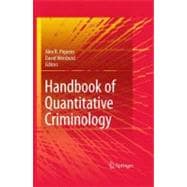
What is included with this book?
| Introduction | p. 1 |
| Descriptive Approaches for Research and Policy: Innovative Descriptive Methods for Crime and Justice Problems | |
| Crime Mapping: Spatial and Temporal Challenges | p. 5 |
| Look Before You Analyze: Visualizing Data in Criminal Justice | p. 25 |
| Group-Based Trajectory Modeling: An Overview | p. 53 |
| General Growth Mixture Analysis with Antecedents and Consequences of Change | p. 69 |
| Spatial Regression Models in Criminology: Modeling Social Processes in the Spatial Weights Matrix | p. 101 |
| Mixed Method Research in Criminology: Why Not Go Both Ways? | p. 123 |
| Descriptive Approaches for Research and Policy: New Estimation Techniques for Assessing Crime and Justice Policy | |
| Estimating Costs of Crime | p. 143 |
| Estimating Treatment Effects: Matching Quantification to the Question | p. 163 |
| Meta-analysis | p. 181 |
| Social Network Analysis | p. 209 |
| Systematic Social Observation in Criminology | p. 225 |
| New Directions in Assessing Design, Measurement and Data Quality | |
| Identifying and Addressing Response Errors in Self-Report Surveys | p. 251 |
| Missing Data Problems in Criminological Research | p. 273 |
| The Life Event Calendar Method in Criminological Research | p. 289 |
| Statistical Power | p. 313 |
| Descriptive Validity and Transparent Reporting in Randomized Controlled Trials | p. 333 |
| Measurement Error in Criminal Justice Data | p. 353 |
| Statistical Models of Life Events and Criminal Behavior | p. 375 |
| Estimation of impacts and outcomes of crime and justice: Topics in Experimental Methods | |
| An Introduction to Experimental Criminology | p. 399 |
| Randomized Block Designs | p. 437 |
| Construct Validity: The Importance of Understanding the Nature of the Intervention Under Study | p. 455 |
| Place Randomized Trials | p. 481 |
| Longitudinal-Experimental Studies | p. 503 |
| Multisite Trials in Criminal Justice Settings: Trials and Tribulations of Field Experiments | p. 519 |
| Estimation of Impacts and Outcomes of Crime and Justice: Innovation in Quasi-Experimental Design | |
| Propensity Score Matching in Criminology and Criminal Justice | p. 543 |
| Recent Perspectives on the Regression Discontinuity Design | p. 563 |
| Testing Theories of Criminal Decision Making: Some Empirical Questions about Hypothetical Scenarios | p. 581 |
| Instrumental Variables in Criminology and Criminal Justice | p. 595 |
| Estimation of Impacts and Outcomes of Crime and Justice: Non-Experimental Approaches to Explaining Crime and Justice Outcomes | |
| Multilevel Analysis in the Study of Crime and Justice | p. 615 |
| Logistic Regression Models for Categorical Outcome Variables | p. 649 |
| Count Models in Criminology | p. 683 |
| Statistical Analysis of Spatial Crime Data | p. 699 |
| An Introduction to Statistical Learning from a Regression Perspective | p. 725 |
| Estimating Effects over Time for Single and Multiple Units | p. 741 |
| Index | p. 765 |
| Table of Contents provided by Ingram. All Rights Reserved. |
The New copy of this book will include any supplemental materials advertised. Please check the title of the book to determine if it should include any access cards, study guides, lab manuals, CDs, etc.
The Used, Rental and eBook copies of this book are not guaranteed to include any supplemental materials. Typically, only the book itself is included. This is true even if the title states it includes any access cards, study guides, lab manuals, CDs, etc.